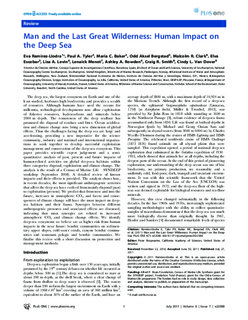| dc.description.abstract | The deep sea, the largest ecosystem on Earth and one of the least studied, harbours high biodiversity and provides a wealth of resources. Although humans have used the oceans for millennia, technological developments now allow exploitation of fisheries resources, hydrocarbons and minerals below 2000 m depth. The remoteness of the deep seafloor has promoted the disposal of residues and litter. Ocean acidification and climate change now bring a new dimension of global effects. Thus the challenges facing the deep sea are large and accelerating, providing a new imperative for the science community, industry and national and international organizations to work together to develop successful exploitation management and conservation of the deep-sea ecosystem. This paper provides scientific expert judgement and a semi-quantitative analysis of past, present and future impacts of human-related activities on global deep-sea habitats within three categories: disposal, exploitation and climate change. The analysis is the result of a Census of Marine Life – SYNDEEP workshop (September 2008). A detailed review of known impacts and their effects is provided. The analysis shows how, in recent decades, the most significant anthropogenic activities that affect the deep sea have evolved from mainly disposal (past) to exploitation (present). We predict that from now and into the future, increases in atmospheric CO2 and facets and consequences of climate change will have the most impact on deep-sea habitats and their fauna. Synergies between different anthropogenic pressures and associated effects are discussed, indicating that most synergies are related to increased atmospheric CO2 and climate change effects. We identify deep-sea ecosystems we believe are at higher risk from human impacts in the near future: benthic communities on sedimentary upper slopes, cold-water corals, canyon benthic communities and seamount pelagic and benthic communities. We finalise this review with a short discussion on protection and management methods. | no_NO |
